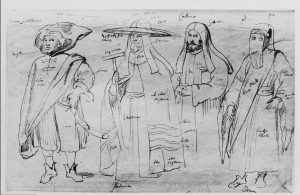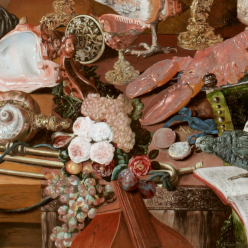
Depicted here is a sketch from 1610-1615 of four figures in oriental dress made in Belgium by the Flemish artist, Peter Paul Rubens. The figure on the farthest right is the figure of interest, as it is the artist’s rendition of a woman wearing an Islamic veil. The significance of this image and this figure in particular is its representation of the detached and misinformed orientalist view which Europeans held of Eastern cultures in the 16thand 17thcenturies. The veil in the drawing does not remotely reflect the actual appearance of veils as staple articles of female apparel in the Ottoman empire that were observed and analyzed by Lady Mary Wortley Montagu. Lady Montagu was a female letter writer in the 17thand 18thcenturies who traveled in Turkey and came to be known as an Enlightenment thinker because of her revolutionary descriptions of foreign culture. Montagu covered subjects such as the veil, introducing new perspectives on objects and ideas that were traditionally looked down upon until that point.
Before Montagu, Europeans generally considered the veil as a perfect symbol of female oppression, an interpretation which, although less common, is still prevalent today. Although the veil as a centerpiece of Islamic culture is clearly an imperfect and controversial item, Lady Montagu began to consider its redeeming qualities for the first time. She went so far as to describe it as a feminist symbol that made Turkish women the only free people in the empire. In her eyes, this freedom stemmed from the anonymity that came with wearing a veil, a power which allowed women to escape their gender role in society and engage in less tolerated activities. One of these activities in which Montagu appeared to have a particular interest was adultery, something which the veil would allow Turkish women to participate in without fear of repercussion. This opened the door to a new interpretation of other elements of sexuality, contributing to one of the major changes of the Enlightenment period which was a review of what was sexually appropriate.
Montagu’s descriptions of the veil also granted it importance as a purely cultural symbol and contributed to the Enlightenment movement away from the orientalist perception of the East. The mere existence of a positive defense and counterargument in favor of the veil introduced a new form of thought to Europe, placing an emphasis on tolerance and appreciation rather than disrespect and aggression when it came to foreign cultures. The first step towards acceptance of foreign culture provided a strong contrast to the approaches of earlier explorers such as Christopher Columbus who immediately resorted to reform and enslavement when encountered with a new culture. The effort to understand the cultures of the “Orient” through items such as the veil eventually evolved into the view of tolerance and validation which we hold today.
Bibliography
Behiery, Valerie. “A Short History of the (Muslim) Veil.” Implicit Religion16, no. 4 (2014). Accessed November 11, 2018. doi:10.1558/imre.v16i4.387.
Grenda, C. S. “Thinking Historically about Diversity: Religion, the Enlightenment, and the Construction of Civic Culture in Early America.” Journal of Church and State 48, no. 3 (2006): 567-600. Accessed November 28, 2018. doi:10.1093/jcs/48.3.567.
Montagu, Lady Mary Wortley. “The Complete Letters of Lady Mary Wortley Montagu.” The Complete Letters of Lady Mary Wortley Montagu,Vol. 1: 1708-1720, 1965, All Pages. doi:10.1093/oseo/instance.00053479.
Murray, James C., Oliver Dunn, and James E. Kelley. “The Diario of Christopher Columbus’ First Voyage to America, 1492-1493.” Hispania74, no. 1 (1991): 72. doi:10.2307/344539.
Peter Paul Rubens. 1610-15. Four figures in Oriental dress, a Moorish warrior, two members of the Greek clergy, a lady with a facial veil. drawing. Place: British Museum, http://www.britishmuseum.org/.
Taylor, Barbara. “Feminism and the Enlightenment 1650-1850.” History Workshop Journal 47, no. 1 (Spring 1999): 261-72. Accessed November 28, 2018. doi:10.1093/hwj/1999.47.261.
